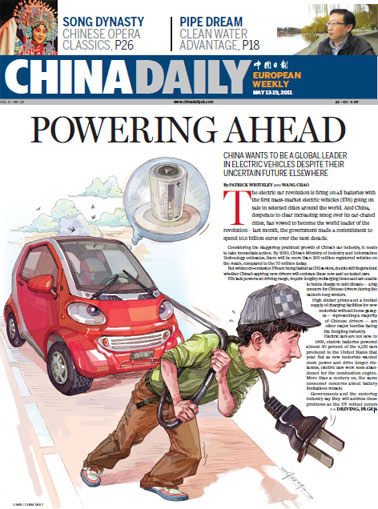Hot issues
E China runs short of power as summer nears
Updated: 2011-05-16 21:35
(Xinhua)
HANGZHOU - With the summer heat drawing near, East China's Zhejiang province is reportedly experiencing the worst power outages in seven years, which is disrupting people's lives and squeezing industrial production.
In order to balance demand and supply, parts of Hangzhou city, capital of Zhejiang province, began power rationing last week, stirring up a spate of complaints and concerns among local residents.
"Since we are already running out of electricity now, I wonder how we can survive the scorching heat that is to come very soon?" asked Ye Fei, a Hangzhou resident.
Zhou Lijuan, manager of a textile company in Jiaxing city, Zhejiang, said, production in her company's plants has been affected by the frequent blackouts during the last few months.
"Colliding with a fluctuation of the exchange rate, the delay of delivery that is caused by the blackouts sometimes leads to a loss of more than 10,000 yuan ($1,535) for each order," Zhu said.
The Zhejiang Electric Power Company is expecting a shortfall of around 350-500 million kilowatts of power in the province during the summer peak when the electricity demand will hit 5,000 million kilowatts, up 25 percent from the present 4,000 million kilowatts.
The power shortage has swept a large part of the country, especially in the eastern and southern regions, as demand rose considerably months ahead of the summer peak season.
According to a circular issued by the National Development and Reform Commission (NDRC), the country's top economic planner, about 20 provinces, autonomous regions and municipalities began rationing electricity since the beginning of this year.
Some experts say the severe power shortage has an implication of a need for more adjustments in the country's economic structure, arguing that the rising demand for electricity, which is straining the country's power supplies, is mainly due to the operation of heavy industries with low energy efficiencies.
Statistics from the National Energy Bureau show that China's electricity consumption in the first quarter of this year has risen 12.72 percent year on year to 1.09 trillion kilowatts/ hours, while about 351.2 billion kilowatts/hours of electricity was consumed by heavy industries with low energy efficiencies, including the chemical, building materials, steel and nonferrous metal industries.
In order to meet the central government's target of saving energy and reducing emissions in the 11th five year plan, which was in place from 2005 to 2010, many factories cut off electricity and reduced production last year. As a result, China has witnessed a sudden revival of the production of the heavy industries since the beginning of this year, which has been adding great pressure to the country' s power generation and transmission systems.
At present, the production of many industries in the country is still by and large dependent upon rampant consumption of energy, said Lin Weibin, deputy director with the Chinese Energy and Strategic Resources Research Center, Beijing Normal University.
More should be done by the government to save energy by eliminating the outdated production capacity, since the power shortage could only be solved in the long term when China shifts its development to a more energy efficient model, Lin said.
Analysts also call for adjustments of the structure within the power generation sector.
As coal is still the main source of energy for the country' s power industry, the rising of the price of coal supplies this year has resulted in power companies losing money, which has worsened the situation of power shortages.
Analysts believe that China should reduce its reliance upon increasingly scarce fossil energy and explore more renewable energy, such as wind, solar, and bio-energy, in order to maintain a more stable and sustainable power supply.
E-paper

Green works
Wuxi becomes 'test case' for facing country's environmental challenges
Preview of the coming issue
The global rise of Chinese brands
China-EU trade on solid ground
Specials

The song dynasty
There are MORE THAN 300 types of Chinese operas but two POPULAR varieties are major standouts

Cut above the rest
One of the world's oldest surgeons has performed more than 14,000 operations

From the ground up
Architect of Guangzhou Opera House has many projects under way, including 2012 Olympics.
